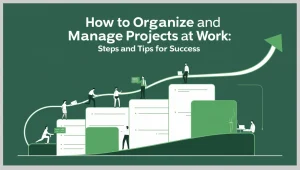The consultative leadership style is becoming more popular in today’s workplaces as organizations value employee feedback, teamwork, and open communication. This style of management fosters an inclusive work environment by allowing team members to participate in the overall decision-making process. This ultimate guide will define consultative leadership, discuss its key concepts, benefits, and drawbacks, and provide practical applications and examples of how to use this leadership style to transform organizational relationships and improve team performance.
What is the consultative leadership style?
To define consultative leadership, one should probably start with its main assumption: leaders consult with their teams before making final decisions. Although the leader retains decision-making power, other perspectives and experiences will be sought and valued. It combines participative and directive leadership, making it useful for striking a balance between inclusiveness and control.
A consultative leader encourages free and clear communication while also empowering employees by allowing them to participate in the development of strategies and operations. It is a style of leadership that involves active listening, mutual respect, and a continuous feedback loop.
Salient features of the Consultative style of Leadership

- Open Communication: Feedback messages are encouraged irrespective of their level in the organization.
- Active Listening: Leaders give the team members time to listen to them.
- Shared Responsibility: Ultimate decisions are made by the leaders, but input is sought in order to make informed decisions.
- Inclusive Decision-Making: Embraces participation among the employees and therefore seeks their input in the formulation of company rules or solutions.
- Trust and Respect: Developing a trusting relationship between the leaders and the employees.
- Continuous Improvement: Leaders appreciate the idea of constant contribution and change strategies.
Decision-Making Process under Consultative Leadership
Advantages of the Consultative leadership style
- Enhanced Employee Participation: Employees participate more willingly when consulted, and this makes them feel special, which raises motivation and participation.
- Enhanced Decision-Making: The views of different people will result in better-informed and balanced decisions.
- Improved Team Functioning: When members feel accepted and listened to, then chances are high that they will deliver a better performance.
- Better working climate: Open communication and transparency provide a better and more cooperative culture of work.
- Talent Development: Employees are developed through their exposure to the leadership processes, and they grow their decision-making capabilities.
- Increased Retention Rates: When employees are engaged and respected, the chances of them remaining in the organization are greatly increased.
Limitations and Challenges
Despite the benefits, the consultative leadership style has the following challenges:
- Consuming: The process of obtaining the views of various stakeholders may make the process of decision-making time-consuming.
- Groupthink risk: Trying to achieve consensus, the critical points of view can be suppressed.
- Input Overdependence: Leaders may not be able to take authority when they are overreliant on the input.
- Not perpetually apposite: In cases of extreme scenarios, urgent decisions might be necessary, and thus, there would be no time to consult.
Consultative Leadership Participative Leadership
Though the consultative leadership style and participative leadership are used interchangeably, there exist some fundamental differences between them:
- Consultative Leadership Style: The leader involves others in getting their suggestions but makes the final decision as well.
- Participative Leadership: It is a shared process of decision-making, and the leader is more of a facilitator.
Both styles encourage teamwork; however, the consultative leadership style has a more distinct hierarchy, which can be advantageous in more organized settings.
Consultative Leadership in Action: Real-Life Examples
- Google has an open culture and consultative leadership style, whereby employees are asked in forums and internal surveys to give their opinions.
- Toyota applies the philosophy of “Kaizen,” according to which constant improvement is carried out with the consultation of the employees on all levels.

Consultative leadership style can work best in the following circumstances:
- Project Planning: When creating a new project that needs cross-functional teamwork.
- Change Management: Where there is a need to make changes in an organization involving different departments.
- Conflict Resolution: In cases where it is very important to mediate and listen to every opinion.
- Strategic Decisions: Long-term planning would be enhanced by a variety of ideas.
The Leadership Style of Consultative Tools that Facilitate the Style
The consultative leadership style can be improved by the use of modern technology:
- Surveys and Polls: Google Forms or Typeform are some of the tools that can be used to collect feedback from leaders among the employees.
- Project Management Software: Asana or Trello are platforms that assist in group planning.
- Communication Tools: Slack, Microsoft Teams, and Zoom will allow real-time input.
- Idea Boards: Miro and MURAL allow conducting visual brainstorming and sharing ideas.
Best Practices to be a Consultative Leader
- Promote Psychological Safety: Team members should not be afraid of sharing opinions, and it is necessary to promote that they are safe to express them.
- Role clarification: Ensure that people know what to do in the decision-making process.
- Establish real timeframes: Delays can be avoided by determining when feedback will be received.
- Authority and Empathy: Balance and Empathy: Balance the final decision politely and inclusively.
- Review Results: Consultation requires evaluation of the results on a regular basis.
Organizational Culture and Consultative Leadership Style
Institutions that adopt a consultative style of leadership have a better chance of establishing a more flexible, shock-resistant, and innovative organizational culture. The relationship between employees and leadership is also enhanced since they will respect each other. The feedback-focused loop and the sense of inclusivity create an atmosphere in which learning is not exhaustive but also welcomed.
The Emotional Intelligence Played a Role
Emotional intelligence is demanded in consultative leadership. The key EI attributes are

- Empathy: Awareness of what other people in the team feel and about what they are worried.
- Self-Awareness: It is the understanding of personal leadership inclinations and prejudices.
- Social Skills: Creation of good interpersonal relations and solution of conflicts.
- Self-Regulation: Cosing emotional reactions, in particular, at the time of strict consultations.
Future Trends: The Relevance of Consultative Leadership Style as Never Before
The increasingly popular remote work, digital transformation, and multigenerational teams are the factors that make the consultative leadership style more crucial. Some of the trends that support this leadership approach are
- Flat hierarchies: A lesser number of rigid structures are being embraced in more organizations.
- Diversity and Inclusion: The differences in opinion are required to make fair decisions.
- Agile Management: The agile techniques involve quick repetition and response.
- Worker Empowerment: The employees are calling out to have independence and a say in work methods.
Concluded: Why Become a Consultative Leader?
The consultative leadership style will change your place of work. It enhances the relationship between leadership and the employee, it enhances the decision-making process, and it raises the satisfaction of the employee. As the world becomes more dynamic in its work situations, this kind of leadership style is more flexible and capable of showing the resilience needed to succeed.
Organizations may develop cultures of trust, innovation, and performance by applying tools, emotional intelligence, and best practices. As a small team leader or a large organization manager, the consultative leadership style will provide you with a tested route to accomplishing the strategic objectives as well as enabling the individuals who make it happen.
Give an example of consultative leadership?
Think of a team leader who is going to organize a new project. They solicit ideas on deadlines and workload in the project by asking team members before deciding on the project timeline. The leader selected the final schedule after listening to the input of everyone.
What does consultative style entail?
- The leader invites the opinion of others.
- promotes the freedom of communication
- Forges trust among the team members
- The making of decisions remains centralized
- Encourages group participation
- Helpful in problem-solving and planning
What is delegating leadership style?
A delegating leadership style is when a leader transfers tasks and decision-making responsibilities to his or her team members. It demonstrates confidence in the capabilities of the team and is readily used when team members are experienced and possess expertise.




